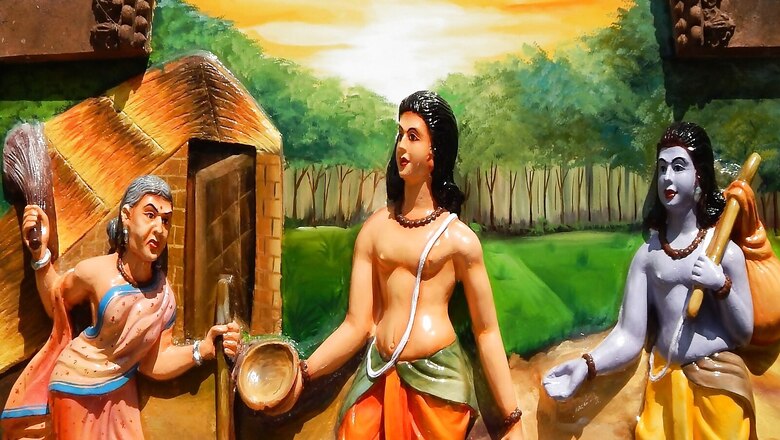
views
Bibek Debroy, in his introduction to his Valmiki Ramayana, explains Ramayana as itihasa (history), not legend or myth. Through Ramayana, Lord Rama has played a significant role in enabling social cohesion and inclusion. Examples are galore to this effect. Valmiki, the author of Ramayana, is also known to have come from the socially marginalised sections of society whom we have profiled in our book. Also, the words of Dr BR Ambedkar lays credence to this, wherein, he says, “The Hindus wanted the Vedas, and they sent for Vyasa, who was not a caste Hindu. The Hindus wanted an epic, and they sent for Valmiki, who was an untouchable. The Hindus wanted a Constitution, and they have sent for me.”
Several versions of the Ramayana also allude to the fact that humans can become God through exemplary qualities and that divinity and humanity are central to Indian literature. Important life sketches and anecdotes help us understand this, be it from the epic story itself or those who have lived and sworn by an unshakeable faith in it. One is Shabari, the iconic tribal woman character, and two is Ramnami, the Dalit religious community founded by Parasuram. They are both integral to India’s societal fabric.
Shabari
Even a cursory look at the epic will enable one to understand that there are two senior women characters in the Ramayana, who are known for their acts that can be regarded as defining moments in the story. One is, of course, Kooni, also known as Mantara, because of whom the thought was seeded in Kaikeyi’s mind to urge Dasharatha to banish prince Rama to the forest and the other is Shabari, a tribal woman who, through her single-minded goal of wanting to meet prince Rama by all means, fulfilled her purpose of life and also led Rama in his onward pursuit of finding Sita.
Oral and written histories have alluded to the characterisation of Shabari. Various versions of the Ramayana allude to the famous story of Shabari meeting Rama and Lakshman. Academicians have also delved into her social origins of hailing from a tribal community. The famous Ramayana serial, televised on Doordarshan that brought the nation to a standstill in its prime, directed by Ramanand Sagar, has identified her more specifically as a Bhil tribal woman. Stories have also added that prior to her taking refuge in Sage Matunga’s ashram (hermitage), she was into hunting and disbanded it to achieve her single-minded goal of meeting Rama.
Tamil poet Kamban’s Ramayana, highlights how Shabari prepared to meet Rama. Shabari is known to have offered fruits tasted by her to Rama. This incident is recounted in Hindi bhajans as well through the lines, “Kaun kehte hai bhagwan khate nahi, tum ber shabri ke jaise khilate nahi” as well as the common phrase “Bhilni ke ber (tribal woman’s jujubes).” Research papers also show consistencies in the versions of Ramayana and its subsequent iterations that she set aside fruits to be served to Rama after tasting them. Ramanand Sagar’s Ramayana also describes Rama asking Lakshman to eat what is given and praising what is given to them at par with what they got from their own mother, Kaikeyi’s hand.
It is because of Shabari that Rama’s journey in the Ramayana was possible. Shabari is known as a woman devoted to Dharma. In Hinduism, Dharma is also defined as one’s duty, besides, of course, it is the substratum of life. In Shabari’s case, we must understand Dharma in light of the tremendous dedication she had towards all her duties. One common thread in learning about Shabari’s life is her association with Rishi Matanga. She committed her full-time service to him and served him until his last moments. She did all this again with the single-minded devotion and duty of standing a chance to meet Rama. After her long penance armed with intense devotion, her wait finally comes to an end. Rama actually comes to meet her with Lakshman. Soon after, she attains her last wish; she leaves her mortal remains. As an aside, there are accounts we read that state how Shabari was against animal slaughter. Some other accounts show she was extremely curious about Ayodhya as she had grown up listening to stories of Ayodhya and King Dasharath’s rule.
Shabari, in our opinion, attained sainthood by practicing the noblest and simplest of virtues and values that are recognised by everyone but lived by a few. Her life can give hope to oppressed communities worldwide. She was not involved in any great initiative of change but the purity of her devotion has had and continues to have a huge impact.
Rama and Ramnami
In recent history, there is another vivid example of single-minded devotion of believing in God only and only through Rama; the Ramnami community. India’s bhakti (devotional) movement has been headlined by the significant contributions of several Dalit personalities: Guru Ravidas, Kabir Das, Nandanar, Soyarabai, and Janabai. The Ramnami community, led by Parasuram, has had to ward off social ostracisation and have tattooed themselves with Rama’s name to highlight not just the fact that God is one but that we are all interconnected as one through the prism of devotion.
The central aspects of the Ramnamis have been chanting Ramnam (the name of Rama) and reciting Ramkatha (the story of Rama). Parasuram, their founder, belonged to the Dalit community. As per Ramdas Lamb, the story of Parasuram is an interesting one. He was stricken with leprosy and wanted to leave his family due to the embarrassment that it would bring them. Just before leaving, he had a surprising experience with a wandering ascetic who told him that Lord Rama was pleased with his devotion and he would get Rama written on his chest during the night. The miracle happened and the entire village celebrated. Following him, several members of the community began to tattoo the name of Rama on their bodies, often earning the ire of the upper-caste communities.
Ramdas Lamb, in his book, Rapt in the Name: The Ramnamis, Ramnam, and Untouchable Religion in Central India, details that in addition to tattooing Rama on their bodies, the Ramnamis wore odhni, cloth covered entirely with the name of Rama. Ramnami men—and occasionally women—also wore mukut (crown), a hat made with peacock feathers, traditionally associated with incarnations of Vishnu such as Rama. The Ramnami community holds an annual mela (festival) which brings together Ramnamis from around Chhattisgarh, as well as visitors from other religious communities.
According to Lamb, Hanuman also finds resonance amongst the Ramnami community in Chhattisgarh. He adds, “Even though the Ramnamis formally reject the worship or veneration of all images and all deities other than Rama, in the eyes of many, Hanuman exists in a sort of mercurial status, outside the boundaries of normal worship practices and classifications.”
On the occasion of Shabari Jayanti, a day dedicated to Shabari, which incidentally falls today, time is ripe for us to understand the diversity of the bhakti tradition embodied in the Ramayana through Shabari and Parasuram. Not just understand, but also communicate it to our own brethren and to the world, at large. Devotion and love formed the fundamentals of their lives. In fact, when Guru Ravidas was stopped from even worshipping in the temple once, he responded, “High or low is just your invention, only love and devotion please the Lord.” Shabari embodied this. No man-made divisions but only love and devotion to all will honour their legacy.
Sudarshan Ramabadran is an author and researcher; Guru Prakash Paswan is BJP national spokesperson. Views are personal.
Read all the Latest Opinions here




















Comments
0 comment